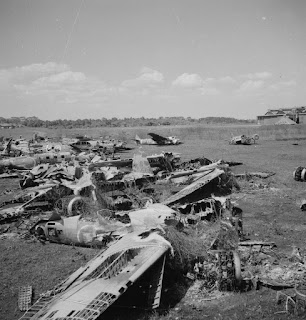A grateful hat tip to Jacob Terlouw for alerting Aviation of Japan to some interesting photos in the National Archives of the Netherlands. The first shows abandoned Japanese aircraft wreckage photographed at Semarang in Java in August 1947. It reveals in the background the remains of at least three Bristol Blenheims in Japanese Army markings and reticulated camouflage. Two appear to be Blenheim IV types whilst the central hulk might just be a Blenheim Mk 1.
The Blenheim IV on the right (shown enlarged above) appears to have been converted into a passenger aircraft with the addition of four fuselage side windows and it retains its engines. According to F. Djoko Poerwoko in 'My Home My Base, Perjalanan Sejarah Pangkalan Udara Iswahjudi 1939-2000' (Lanud Iswahjudi 2001, p.49-66) a Blenheim IV had been re-fitted with Japanese Nakajima Sakai engines. After a brief 15 minute test flight at Maospati on 13 November 1946 this aircraft crashed and was a total write-off but the pilot Suhanda and his five passengers were unharmed. According to Wiweko Soepono in 'Dari Blitar ke Kelas Dunia', (Jakarta 2002, p.64-134) the Blenheim was modified to carry passengers but was too nose heavy so three bags of sand were placed in the tail end of the fuselage. The aircraft flew three circuits over Madiun but then crashed when attempting to land.
The Blenheim IV on the right (shown enlarged above) appears to have been converted into a passenger aircraft with the addition of four fuselage side windows and it retains its engines. According to F. Djoko Poerwoko in 'My Home My Base, Perjalanan Sejarah Pangkalan Udara Iswahjudi 1939-2000' (Lanud Iswahjudi 2001, p.49-66) a Blenheim IV had been re-fitted with Japanese Nakajima Sakai engines. After a brief 15 minute test flight at Maospati on 13 November 1946 this aircraft crashed and was a total write-off but the pilot Suhanda and his five passengers were unharmed. According to Wiweko Soepono in 'Dari Blitar ke Kelas Dunia', (Jakarta 2002, p.64-134) the Blenheim was modified to carry passengers but was too nose heavy so three bags of sand were placed in the tail end of the fuselage. The aircraft flew three circuits over Madiun but then crashed when attempting to land.
Another view of the same wreckage (above) reveals an interesting tail marking on a Ki-54 of what appears to be a stylised '5' or 'S' superimposed on a horizontal stripe. Semarang was within 9th Air Division's sphere of operations as part of 3rd Air Army. The 9th's Headquarters Flight (Shireibu Hikohan) marking is reported to be the white Chinese character 'Shô' (翔 - to fly or soar) set on a white bordered Hinomaru symbol. Also under 3rd Air Army's command was 5th Air Division coveringBurma, Thailand and Indo-China. The tail symbol used by the 5th's HQ flight from October 1943 was a highly stylised representation of the Japanese character for '5' (五) appearing a little like an old-fashioned sand timer. But perhaps the marking changed again? The transport Blenheim seems to have a similar marking.
Two good clear close up photographs of a Ki-79 show useful details like the bomb rack, (presumably on a special attack aircraft), aerial mast, telescopic sight mounting, the eliptical cooling slots, the way the slotted undercarriage shaft extends above the wing with oleo compression and drooped flaps. Paint colours are conjectural but probably severely sun bleached with evidence of over painting.
A photograph of two Yokosuka K5Y1 'Curen' trainers in Indonesian markings reveals the interesting detail that the AURI insignia appears on the port upper wing only. As there is no indication of overpainting of any Hinomaru on the starboard upper wing it seems probable that they had been completelt re-painted. The two aircraft appear to have been photographed at Maguwo (now Adisucipto Airport) as their 'TJ' tail codes and fuselage numbers '54' and '72' (?) are recorded in other photographs and documents (Bakti TNI Angkatan Udara 1946-2003, TNI-AU, Jakarta 2003, p.11, 16, 20-42). A total of 75 K5Y1 were left in Indonesia of which 70 were seized by AURI and from 20-32 became operational.
Image credits: All photos: Fotograaf Onbekend/DLC National Archives of the Netherlands/Fotocollectie Dienst voor Legercontacten Indonesië, CC-B;
Two good clear close up photographs of a Ki-79 show useful details like the bomb rack, (presumably on a special attack aircraft), aerial mast, telescopic sight mounting, the eliptical cooling slots, the way the slotted undercarriage shaft extends above the wing with oleo compression and drooped flaps. Paint colours are conjectural but probably severely sun bleached with evidence of over painting.
A photograph of two Yokosuka K5Y1 'Curen' trainers in Indonesian markings reveals the interesting detail that the AURI insignia appears on the port upper wing only. As there is no indication of overpainting of any Hinomaru on the starboard upper wing it seems probable that they had been completelt re-painted. The two aircraft appear to have been photographed at Maguwo (now Adisucipto Airport) as their 'TJ' tail codes and fuselage numbers '54' and '72' (?) are recorded in other photographs and documents (Bakti TNI Angkatan Udara 1946-2003, TNI-AU, Jakarta 2003, p.11, 16, 20-42). A total of 75 K5Y1 were left in Indonesia of which 70 were seized by AURI and from 20-32 became operational.







6 comments:
Hi Nick,
That Curen (or originally Tjureng)- what explains the TJ-code- was indeed the 72
according to Het 6 ARVA Squadron in Nederlands-Indie 1946-1950 page 193.
Jacob.
Thanks Jacob!
Regards
Nick
Absolutely sensational finds!
Very interesting to know!
Thanks for sharing these surprising pictures, Jacob.
Thanks for posting, Nick.
Regards,
Ken Glass
Post a Comment